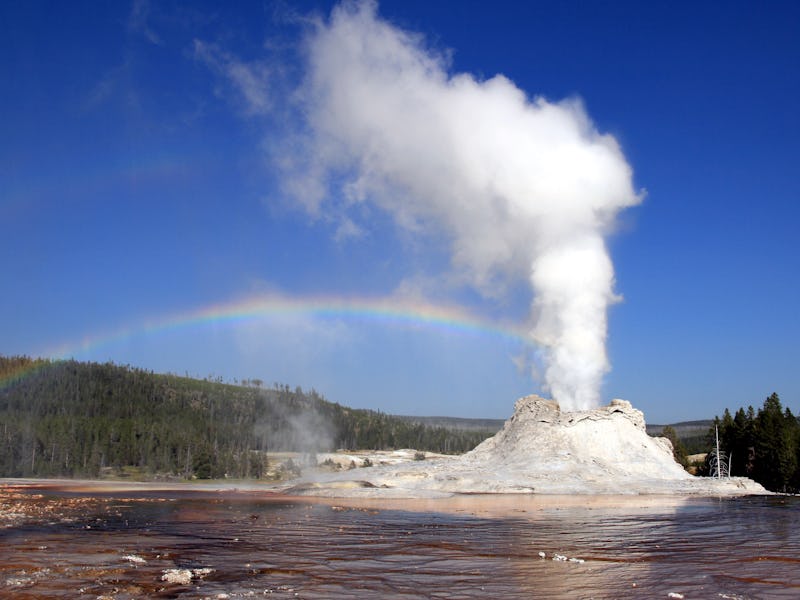Everything You Need to Know About the Yellowstone Supervolcano
Yes, you are standing in the mouth of an active volcano. Yes, it's fine.

Fears of an imminent eruption of Yellowstone National Park’s supervolcano were stoked by a swarm of earthquakes in Montana last week.
A lot of the information floating around the internet was sensationalized or straight-up fake news: While it’s true that a large chunk of the park is essentially the mouth of a massive, active volcano, that volcano hasn’t seen actual lava flows in 70,000 years, and scientists are not worried about impending disaster.
The geology of Yellowstone is a result of volcanic activity. Those processes continue to shape the area, making it the geologically exciting place it is today. Hot springs and geysers are evidence of magma flowing relatively close to the Earth’s surface.
Past volcanic activity in the area has been devastating. Of three major eruptions in the last two million years, two were large enough to have the area declared a supervolcano, which means more than 240 cubic miles of magma were ejected each time.
The Yellowstone volcano works much like any other volcano, although it is much wider and flatter than the prototypical conical volcano.
Supervolcanoes look very different from how we tend to imagine volcanoes, in part because they are so big and so explosive. The classic conical volcano shape happens as smaller lava flows build up over a very long time, but supervolcanoes don’t work that way. Imagine a chamber of lava twice the volume of Lake Erie suddenly erupting from below the Earth’s crust and blasting open like a pressure cooker bomb; rock and magma would be ejected for hundreds of miles in all directions.
After the event is over and the lava solidifies, the rocks in the area sort of collapse downwards into the space where the magma-filled chamber once was. This forms a giant bowl-like depression in the ground called a caldera, from the Spanish for “cooking pot.” It’s an apt description both of the caldera’s shape and the method of its formation.
Yellowstone’s volcano is a hotspot volcano. Rather than existing at the boundary between tectonic plates, it finds itself over a pocket of magma that has churned its way up through the planet’s crust. Pressure can build up in these hotspots over time, until it either dissipates from below or break through above in a volcanic eruption.
This USGS map shows the location of volcano monitoring systems in and around Yellowstone National Park. The blue line is the park boundary, and the caldera is outlined in orange.
Yellowstone National Park boasts three calderas, one from each of the major eruptions of the past two million years. You can actually stand on the edge and see the rim of this wide hole in the Earth. The Yellowstone Caldera, which is the name for the collective depressions from all three eruptions, measures about 30 by 45 miles. When you stand within it, you are literally in the mouth of an active supervolcano.
And the supervolcano is rumbling. About 1,000 to 3,000 earthquakes are recorded each year in the vicinity of Yellowstone, evidence of churning magma below. Most of these are very small — too subtle to feel even if you stood right above the epicenter. Geologists also track surface deformation, which is the movement of the surface of the Earth up and down in response to changing magma pressures below.
This all seems quite worrisome, but scientists insist a visit to Yellowstone is safe. You should be more concerned about errant geysers magma-heated water than a sudden supereruption. While the Yellowstone volcano could conceivably erupt any time, scientists expect that warning signs would pop up before an eruption, including a dramatic change in patterns of seismicity and uplift. So far, geologists and volcanologists say we’re safe, and that the supervolcano will give due warning if it is about to blow.
Massive volcanic eruptions of the distant past formed the landscape of Yellowstone National Park.
Earthquakes in surrounding regions do affect hydrothermal activities in Yellowstone. In the past, major seismic events hundreds of miles away have changed observed patterns at Yellowstone’s hot springs and geysers.
But it’s unlikely that an earthquake in Montana would suddenly cause magma to rip through the crust of the Earth in Wyoming. To understand what is going on in the Yellowstone volcano, it’s best to go directly to the source. And that’s what geologists are doing, by using scientific instruments to track earthquakes, surface deformation, temperature, and other indicators that the beast might be waking up. Like a bear rising from a long hibernation, the supervolcano will grumble before it roars.